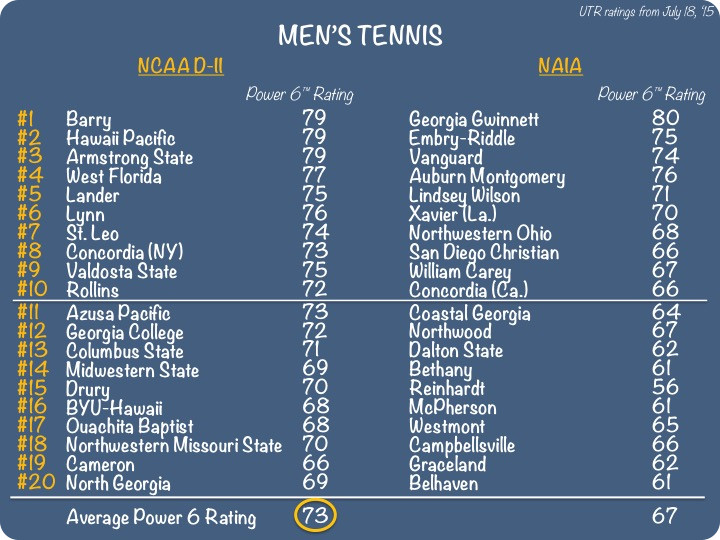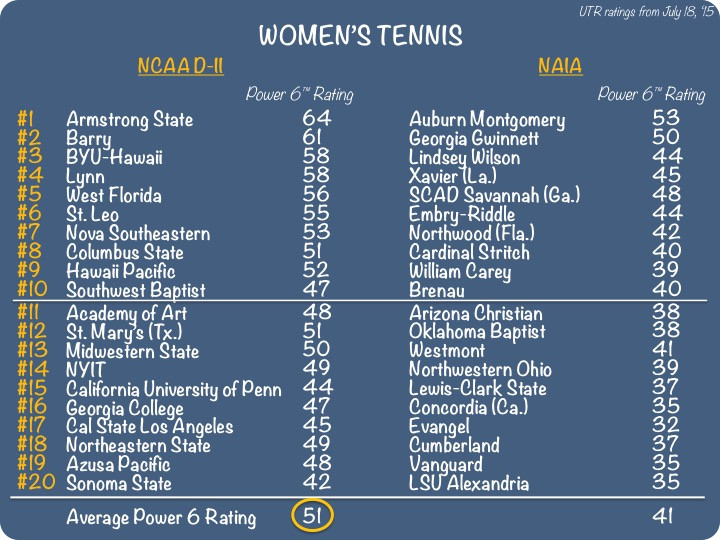NCAA Division II or NAIA Tennis

"I want to go to a big school, and I want to be a starter in a strong team."
Above is a typical statement by young tennis players who are looking to get a scholarship. Boys and girls alike, most of them emphasize that it's NCAA D-I tennis they have in mind. It is right there we then mention that college tennis is more than just one division. While some kids have heard of NCAA D-II, D-III, NAIA, and NJCAA, they are often surprised when it comes to availability of scholarship money in NCAA D-II and NAIA. "But what is the difference really between these two divisions when it comes to level of play?" is a common question we get.
That made us want to look a little closer into the actual difference. But how to best go about it? Do you compare the junior, college, or international rankings and tournament results of a selection of players? Or some of the dual matches, which have been played between NCAA and NAIA teams? All that does sound like a lot of work... Good thing the Universal Tennis Rating makes this comparison a lot easier and reliable. If you're not yet familiar with the UTR, here's a description of what it is the organization is offering to the tennis world:
UTRs range from 1.00 (beginners) to 16.50 (top professionals) and are calculated based on each player's last 30 match results for matches played within the last 12 months.
So, we started out by listing the Top 20 ranked teams in the NCAA D-II (Men's & Women's) and compared their rosters to the Top 20 ranked teams in the NAIA (Men's & Women's), on the basis of the final NCAA and NAIA rankings from May/June 2015.
Universal Tennis provides a "Power 6 Rating", which calculates the combined ratings of the 6 highest-rated players on the team. It's fair to assume those players represent the starting line-up. In a second step we then applied the top 20 teams' Power 6 rating instead of going through the UTRs of all players individually.
We had a pretty good idea of the level of play before, but it feels tons better to be able to get it backed up with solid and reliable data - see for yourself below:
Men's Tennis

On the men's side, the Top 20 NCAA D-II teams have an average combined Power 6 Rating of 73. In other words, the average player in a Top 20 team has a UTR of around 12.20. Compared to this, the NAIA Top 20 teams have an average combined rating of 67 or 11.20 per player.
A look at Gwinnett's (NAIA) 2014-15 schedule shows that they only fell short against Barry and Hawaii Pacific, while celebrating victories against all other NCAA D-II teams played. As many of you might be even more familiar with NCAA D-I levels, a comparison is in place to put it in the right context:
- NCAA D-I #1 ranked University of Virginia has a Power 6 Rating of 87. (#1 NCAA D-II Barry: 79, #1 NAIA Georgia Gwinnett: 80)
- NCAA D-I #20 Stanford has a rating of 83. (#20 NCAA D-II North Georgia: 69, #20 NAIA Belhaven: 61)
- Where would #1 Barry and Georgia Gwinnett be in the highest college division? According to the Power 6 Rating, Princeton is the highest ranked team (#35) with the same rating as #1 Barry (79), and University of San Diego the highest ranked team (#22) with the same rating as #1 Georgia Gwinnett (80).
Women's Tennis

On the women's side, the Top 20 NCAA D-II teams' average is a combined rating of 51. In other words, the average female player in a Top 20 team has a UTR of around 8.50. Compared to this, the NAIA Top 20 teams have an average team rating of 41 or 6.80 per player.
The two divisions' top teams met last February, and Armstrong walked off the court with a convincing 9-0 victory, supporting the picture the data draws. Again, we'll also compare the teams to D-I tennis:
- NCAA D-I #1 ranked Vanderbilt University has a rating of 68. (#1 NCAA D-II Armstrong: 64, #1 NAIA Auburn Montgomery: 53)
- NCAA D-I #20 Georgia Tech a combined rating of 63. (#20 NCAA D-II Sonoma State: 42, #20 NAIA LSU Alexandria: 35)
- Here again, what role would #1 Armstrong and Auburn Montgomery play in the highest college division? According to Universal Tennis, Texas Tech is the highest ranked team (#16) with the same rating as D-II #1 Armstrong (64), whereas NAIA #1 Auburn Montgomery would be unranked.
Results
So what does this all tell us? It tells us that NCAA D-II men's and women's tennis is stronger than NAIA tennis. How much stronger? Well, that depends, but while the top ranked teams on the men's side are relatively close to each other, there is quite a gap on the women's side, which continues all the way down to lower ranked teams.
Prospective student-athletes should be aware of the various college choices. Part of this is knowing about the different divisions. Not every player is D-I material, and that's totally fine. There's so much great tennis taking place in "Small College" Tennis. Get a UTR, compare yourself to the level of play of different teams, sign up for free on Smarthlete - the tennis recruiting platform, and contact the right coaches looking for players with your rating.
Let's find out together whether you're future is in D-I, D-II, NAIA or any of the other college tennis divisions!
Make sure you stay informed about what's happening in college tennis and follow us on Facebook, Instagram, or Twitter.